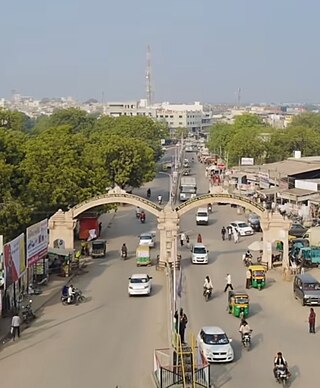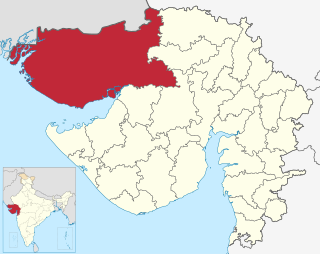
Tharad is a town in Tharad taluka in the Banaskantha district of the state of Gujarat in India. It is the administrative center of Tharad taluka. Tharad is near the border of Gujarat, 40 km from the border with Pakistan and 15 km from the Indian state of Rajasthan. Its main industries are agriculture and diamond polishing. It is one of the first major towns in Gujarat on National Highway 15.
Kankrej thana or Kankrej Estates was a former collection of native states in what is now part of Banaskantha district of Gujarat, India.

Vav is a town and the headquarters of Vav Taluka in Banaskantha district in Gujarat state of India. Vav is the largest taluka of the district.
Desalpar Gunthli is a village and site belonging to Indus Valley civilisation located at Nakhtrana Taluka, Kutch District, Gujarat, India. Desalpar is approx 25 km away from Bhuj. This site is of modest dimensions,(130 m by 100 m ) situated on the northern banks of once depredatory (erosive) stream, Bamu-Chela, an affluent of the Dhrud river.
Adesar is a small village in Kutch district, Gujarat, India.
Amrapar is a village in Kutch district, Gujarat, India.
Gedi is a village near Rapar of Kutch district of Gujarat, India.

Gundiyali is a village near Mandvi of Kutch district of Gujarat, India.
Rav is a village of three hamlets; Rav Moti, Rav Nani and Temple; in an open plain, located nineteen miles from Chobari, in Rapar Taluka of Kutch district of Gujarat, India.
Vinzan or Vinjhan is a village in Abdasa Taluka in Kutch district of Gujarat, India.

Vira is a village in Anjar Taluka in Kutch district of Gujarat, India. Nearby temple of Jogninar is place of religious significance.
Patgadh or Vagham Chavdagadh was a historical town and capital of western Kutch during rule of Chawda dynasty. The ruins of the town is located in Lakhpat Taluka in Kutch district of Gujarat, India. The village is on the west bank of Little Rann of Kutch.
Captain James MacMurdo was the first political resident of British East India Company to Cutch State. He played important role in bringing kutchh under British suzerainty.

The history of Kutch, (kachchh) a region in the extreme west of the western Indian state of Gujarat, can be traced back to prehistorical times. There are several sites related to Indus valley civilization in region and is mentioned in Hindu mythology. In historical times, Kutch is mentioned in Greek writings during Alexander. It was ruled by Menander I of Greco-Bactrian Kingdom which was overthrown by Indo-Scythians followed by Maurya Empire and Sakas. in the first century, it was under Western Satraps followed by Gupta Empire. By fifth century, Maitraka of Valabhi took over from which its close association with ruling clans of Gujarat started. Chavdas ruled the eastern and central parts by seventh century but then came under Chaulukyas by tenth century. After fall of Chaulukya, Vaghelas ruled the state. Following conquest of Sindh by Muslim rulers, Rajput Samma started moving southwards to Kutch and ruled western regions initially. By tenth century, they controlled significant area of Kutch and by thirteenth century they controlled whole of Kutch and adopted a new dynastic identity, Jadeja.
The history of Palanpur starts with its relation to the historic city of Chandravati ruled by Paramara dynasty. The town was re-peopled and ruled by Chauhans around thirteenth century. At the start of the seventeenth century, the Palanpur State was taken over by Jhalori dynasty of Pashtun Lohani (Bihari-Pathan) tribe which was founded in 1373 and ruled from Jhalor. The dynasty came into historical prominence during the period of instability that followed the demise of Mughal Emperor Aurangzeb in the early 18th century. It was overrun soon afterwards by the Marathas; the Lohanis followed the trend of seeking recourse in the British East India Company against them and finally entered the subsidiary alliance system in 1817, along with all other neighbouring states, becoming a British protectorate governed by Palanpur Agency. After independence of India in 1947, Palanpur State was dissolved in 1949 and merged with India as a part of Bombay State. Subsequently, Palanpur became the capital of Banaskantha district of Gujarat.(Hebatpur) Currently Maximum Jagirdar Families Living In Hebatpur Village:12 Km Away From Palanpur. In Addition:5 Villages Lohani Family. 42 Villages Bihari Families. Also Pathan & Ghori Families.
Varahi is a village in Santalpur taluka of Patan district of Gujarat state of India.
Suigam was a village in Vav Taluka of Maratha Riyasat in Gujarat, India, but it is now a Taluka of Banaskantha district in Gujarat.
Morvada is a village in Vav Taluka of Banaskantha district in Gujarat, India.
Kasara is a village in Kankrej Taluka of Banaskantha district in Gujarat, India.
Vaghel is a village in Harij Taluka of Patan district in Gujarat, India.





